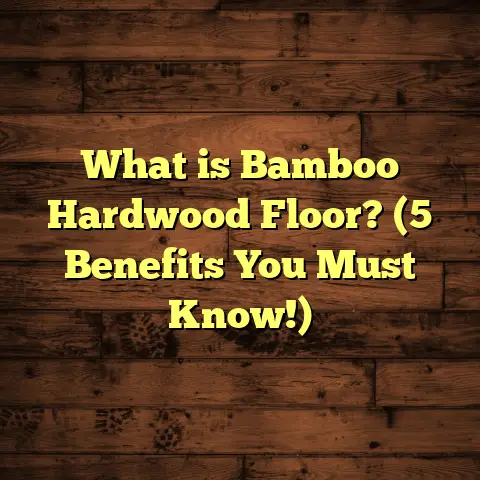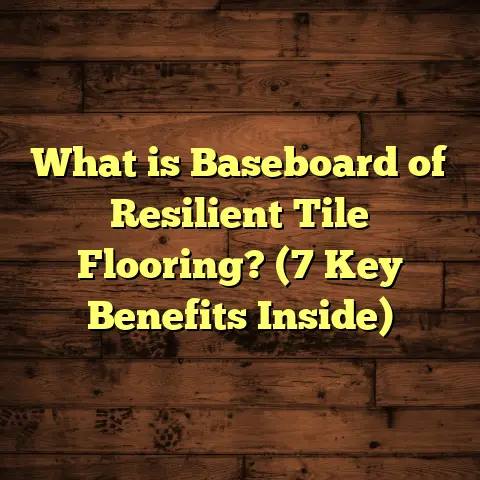What is Better Flooring: Laminate or Hardwood? (5 Key Comparisons)
I want to talk about a question I hear a lot from homeowners and renovators alike: What flooring is better—laminate or hardwood? One of the first things people notice when comparing these two options is how easy they are to maintain. I’ve worked with both extensively, and I know firsthand how much maintenance—or lack thereof—can influence the happiness you get from your floors.
When I installed hardwood in my own house, I discovered quickly that keeping it looking perfect requires more attention than laminate. But then again, laminate doesn’t have that warm, natural vibe hardwood exudes. And if you have kids or pets, durability and scratch resistance become huge factors.
Today, I want to walk you through everything I’ve learned over the years, breaking it down into five key points that really helped me and my clients decide what’s right for their homes.
What Exactly Are Laminate and Hardwood Floors?
Before we jump into comparisons, let’s clarify what these floors really are. It might seem obvious—after all, they both look like wood, right? But they’re quite different in how they’re made and how they perform.
Laminate Flooring: The Composite Wood Lookalike
Laminate flooring is a synthetic product that’s designed to look like wood. It’s made of several layers:
- A wear layer on top that protects the floor from scratches and moisture.
- A photographic layer underneath that gives the wood-like appearance.
- A core layer of high-density fiberboard (HDF) or medium-density fiberboard (MDF).
- Sometimes a backing layer for stability and moisture resistance.
This layered construction makes laminate durable and affordable. The top wear layer is often treated with melamine resin, which is why laminate can resist scratches better than many hardwood finishes.
When I first started working with laminate floors about a decade ago, they looked quite plastic and fake. But technology has come a long way. Now, high-quality laminates replicate wood grain textures and colors almost perfectly—even under close inspection.
Hardwood Flooring: The Real Deal
Hardwood floors are made from solid wood planks cut directly from trees. You have two main types here:
- Solid hardwood: Single pieces of wood throughout the thickness (usually 3/4 inch thick).
- Engineered hardwood: A thinner veneer of real wood on top of plywood layers glued together.
Engineered hardwood is designed to be more stable in humid or variable climates because the multiple layers prevent the wood from expanding and contracting as much as solid hardwood.
When you walk barefoot on hardwood, you feel its natural warmth and solidity. The grain patterns vary depending on the species—oak, maple, walnut, cherry—and this uniqueness adds character to every plank.
I remember installing solid oak floors for a client who was adamant about having “authentic” wood underfoot. The moment she stepped onto those polished planks, she told me it felt like her home had “come alive.”
Why Does This Matter?
Because the differences in construction affect everything else—the durability, the look, the cost, and even how you clean and maintain these floors.
1. Durability and Wear Resistance: How Tough Will Your Floors Be?
One of the most important questions I get asked is: Which floor will hold up better under heavy use?
Laminate’s Durability: Scratch-Resistant but Sensitive to Water
Laminate floors have a reputation for being tough against scratches and dents. That top wear layer can handle pet claws, dropped keys, or moving furniture without showing much damage.
In fact, in lab tests by flooring manufacturers, laminate’s scratch resistance often outperforms hardwood finishes like polyurethane or aluminum oxide coatings. According to data from the National Wood Flooring Association (NWFA), laminate can resist scratches up to 10 times better than some hardwood finishes.
But there’s a catch: laminate isn’t very forgiving with water. If moisture seeps into the fiberboard core, it swells and warps. This makes spills or humidity a potential problem unless you act fast.
I’ve seen laminate floors in homes where water leaks or spills were left unattended. The edges swell up like little balloons—a problem that can mean replacing entire sections.
Hardwood’s Durability: Can Be Refreshed for Decades
Hardwood is naturally durable but softer than laminate in terms of scratch resistance—depending on the species. For example:
- Oak has a Janka hardness rating around 1,200.
- Maple scores about 1,450.
- Hickory, one of the toughest woods, reaches 1,820.
The Janka hardness test measures how much force it takes to embed a steel ball into wood—higher means tougher.
The upside? When hardwood does get scratched or dented, it can be sanded down and refinished multiple times over its lifetime. This process removes surface damage and restores its beauty.
A client of mine had 80-year-old hardwood that looked rough from years of wear. After a professional sanding and refinishing job, it looked as good as new—something you just can’t do with laminate.
Longevity Comparison by Numbers
- Laminate lifespan: 15-25 years (depending on quality and traffic).
- Hardwood lifespan: 30-100+ years with proper maintenance.
For families with kids or pets who want easy cleanup but still decent durability, laminate works well. If you want an investment that lasts generations and can be revived again and again, hardwood is unbeatable.
2. Appearance and Feel: What Will Your Floors Look and Feel Like?
Everyone wants floors that look great—but what about how they feel? There’s more to flooring than just appearances.
Hardwood Floors: Natural Beauty That Ages Well
Hardwood offers something laminate can’t quite replicate—a natural warmth and texture that changes over time.
Each plank has unique knots, grain patterns, and color variations. These imperfections create character that makes your home feel cozy and timeless.
When you walk barefoot on hardwood, you feel that solid support underneath your feet. The wood also responds slightly to temperature changes—warm in winter, cool in summer—which adds comfort.
Over time, hardwood develops a patina that many homeowners find beautiful. It’s like wine aging; the floor tells your home’s story through subtle changes in color and wear patterns.
Laminate Floors: Improved Realism but Limited Tactile Warmth
Laminate has come a long way in mimicking wood visually. High-definition photographic layers combined with embossed textures can fool most people at first glance.
I once installed laminate in a vacation rental where budget was tight but appearance mattered. The owner was thrilled with how authentic the floors looked on camera for listing photos.
But step on it barefoot during colder months, and you’ll notice it feels harder and less warm than wood. The fiberboard core doesn’t have the same density or natural insulation as hardwood.
Also, laminate doesn’t age like hardwood—it maintains its original look until it wears out or gets damaged.
Color Stability
Hardwood color changes over time due to sunlight exposure and oxidation. Some woods darken; others lighten. This natural aging adds charm but may surprise if you expect consistent color.
Laminate colors stay stable because they’re printed images sealed under plastic layers—not affected by UV rays the same way.
3. Installation Process and Cost: What Will It Take to Get These Floors In?
If you’re planning a project yourself or working with contractors, installation time and cost might tip your decision one way or another.
Installing Laminate: Quick and DIY-Friendly
One reason I often recommend laminate is how fast it goes down. Most laminate uses a click-lock system where planks snap together without glue or nails.
This “floating” method means installation takes less time—sometimes just a day or two for an average room—and less mess.
Because it doesn’t require special tools or adhesives, many homeowners tackle laminate installation themselves successfully. If you’re handy with basic tools like saws and spacers, this can save money on labor costs.
Hardwood Installation: More Time, More Expertise Needed
Hardwood installation is more involved:
- Solid hardwood usually requires nailing or stapling down planks onto a plywood subfloor.
- Engineered hardwood can sometimes be glued down or floated but often requires professional installation.
Hardwood also needs acclimation time to adjust to indoor humidity before installation. This can add days to your schedule since wood expands or contracts based on moisture content.
Due to these factors, hardwood installation typically costs more in labor—sometimes double what laminate costs to install per square foot.
Cost Breakdown (Material + Installation)
| Flooring Type | Material Cost (per sq ft) | Installation Cost (per sq ft) | Total Approximate Cost |
|---|---|---|---|
| Laminate | $1 – $3 | $1 – $2 | $2 – $5 |
| Hardwood (solid) | $5 – $10 | $3 – $5 | $8 – $15 |
| Engineered Hardwood | $3 – $7 | $3 – $5 | $6 – $12 |
Prices vary by region and product quality but this should give you an idea.
Waste Factor
Don’t forget ordering extra material! I always tell my clients to buy 5-10% more flooring than room measurements call for—to cover cuts, mistakes, or future repairs.
4. Maintenance and Cleaning: How Much Work Will Your Floors Need?
Here’s where many people either fall in love or get frustrated with their choice.
Laminate Cleaning: Simple and Low Maintenance
Laminate floors require very little upkeep beyond regular sweeping to remove dirt and grit that could scratch surfaces.
A damp mop with a laminate-specific cleaner once in a while keeps them shiny and fresh. Avoid soaking floors with water; excess moisture can cause swelling at seams.
Stains like food spills wipe off easily without staining laminate since the surface is sealed tightly.
In homes with kids who drop snacks everywhere or pets who track dirt indoors, this ease of cleaning is a lifesaver.
Hardwood Cleaning: Needs Careful Attention
Hardwood floors need a gentler touch:
- Sweep or vacuum frequently to prevent grit damage.
- Clean spills immediately to avoid water damage.
- Use cleaners formulated for hardwood—not harsh chemicals or ammonia-based products that degrade finishes.
Every few years—or more often in high traffic areas—hardwood floors benefit from refinishing or buffing to restore their protective coating.
This level of maintenance can feel like extra work but pays off by extending the floor’s life significantly.
5. Environmental Impact and Longevity: Thinking Long-Term?
More homeowners ask about sustainability these days—understandable given how much impact building materials have on our planet.
Hardwood: Renewable but Requires Responsible Sourcing
Wood is a renewable resource when harvested sustainably. Many manufacturers now offer certifications like FSC (Forest Stewardship Council) to ensure forests are responsibly managed.
Hardwood floors absorb carbon dioxide during tree growth—a positive environmental effect—and are biodegradable at end-of-life.
Their ability to be refinished again and again means fewer resources used over decades compared to replacing floors multiple times.
I’ve worked with clients who specifically requested FSC-certified wood because they wanted their renovation to be eco-friendly from start to finish.
Laminate: Mostly Synthetic but Improving
Laminate contains synthetic resins and adhesives derived from petrochemicals plus wood fiber byproducts bonded together.
While some brands focus on low-VOC (volatile organic compound) emissions or use recycled content in cores, overall laminate isn’t as green as solid wood.
Production involves more energy-intensive processes too. A life cycle assessment showed that producing one square foot of laminate flooring generates nearly twice the carbon footprint of sustainably harvested hardwood.
Still, if laminate lasts 15-20 years longer than cheaper alternatives it replaces—some argue it can be environmentally viable when managed properly.
Personal Stories & Lessons From My Projects
I want to share some real-life examples from my experience:
- The Busy Family Home: I installed laminate in a household with three kids under ten and two dogs running around nonstop. Their floors survived spills, scratches from toys, even muddy paws without complaint after five years—much easier than if I’d recommended hardwood.
- The Historic Renovation: A couple bought an old Victorian home and insisted on original oak flooring refinished rather than replaced with laminate. The result was stunning—a floor that added value and charm while lasting over 100 years already.
- Vacation Rental Owner: Wanted affordable floors that looked great on camera but wouldn’t break the bank after guest wear-and-tear. Laminate was perfect; installation was fast between bookings too.
- Environmentally Minded Client: Chose FSC-certified engineered hardwood for sustainability reasons even if cost was higher upfront—they wanted longevity without compromise on natural materials.
Each scenario shows how important it is to match flooring choice to lifestyle needs rather than just aesthetics or cost alone.
Quick Reference Summary Table
| Feature | Laminate | Hardwood |
|---|---|---|
| Durability | Scratch-resistant; sensitive to water | Durable; can be sanded/refinished |
| Appearance | Realistic wood look; less warmth | Natural wood; unique grain & texture |
| Installation | Fast; DIY-friendly; click-lock | Slower; professional recommended |
| Cost | Lower upfront | Higher upfront; longer lifespan |
| Maintenance | Easy; damp mop only | Regular care; refinishing needed |
| Environmental Impact | Synthetic materials; higher carbon footprint | Renewable; biodegradable; sustainable options available |
| Longevity | 15-25 years | 30-100+ years |
Final Thoughts From Someone Who’s Seen Both Sides
Choosing between laminate and hardwood floors isn’t just about picking the “best” flooring overall—it’s about what fits your life best right now.
If you want something tough, budget-friendly, quick to install, and easy to clean—and don’t mind synthetic materials—laminate wins hands down.
If you prefer natural materials that feel warm underfoot, have timeless beauty that lasts decades (or more), don’t mind spending extra time maintaining them—and see flooring as an investment—hardwood is tough to beat.
Both options have come a long way technologically so don’t underestimate either when making your choice!
Have questions about specific manufacturers? Wondering about installation tips? Or curious about maintenance hacks I use daily? Just ask—I’m happy to share everything I know from years on the job!





